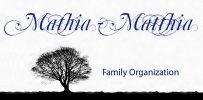DNA: A Helpful Tool
Almost all past Mathia-Matthia research is based on following the paper trail. Searching vital, church and other records is efficient and effective if those records were created, survived and complete enough to answer our research questions. Unfortunately, following the paper trail for decades has left us with unanswered questions.
DNA science, testing, databases, and affordability are now within ready reach as new tools for Mathia-Mathia research, and we want to move ahead with them.
Maria Mathia who manages Pawel Mathia’s DNA account at FamilyTreeDNA.com has created a Matthia-Matthia Surname Group Project hosted there. Registration and following the project are free, but DNA tests are not free.
Autosomal DNA
Autosomal DNA is passed on from both parents with about 50% coming from the mother and 50% from the father. Because of this continuous mixing, autosomal DNA is only useful for about five generations. After that, everything becomes too fuzzy to see. Many remaining Mathia-Matthia research questions are about earlier generations of the family. A better tool is needed to answer family questions that precede the 19th Century.

Y-DNA
Y-DNA, is usually passed from father to son and on to grandsons without any dilution caused by mixing. Y-DNA testing and comparison has the potential of answering some of our remaining Mathia-Matthia research questions.
In medieval times and earlier most people did not carry last names from generation to generation, but were identified locally by who their father was (e.g., Lars Johnson or Simon bar Jonah, called patronymics) or by some other characteristic (e.g., a physical feature, where they came from, their occupation, etc.).
At varying points in history, family surnames became a local custom. Surnames began to be passed from fathers to their family members. By custom, sons carried the surname on (and unbeknownst their Y-DNA). Daughters most often took on the surnames of their husbands (and had no Y-DNA to pass on).
When the Mathia-Matthia family of phonetic surnames began (most people couldn’t spell), the surname may have been adopted because of a tribal name (e.g. Mathiaker) or because of a patronymic (e.g. their father’s given name was Mathia or Matthia taken from the Bible).
Throughout the entire historical period, migrations for religious, economic, social, and political reasons (including war) were common.
Looking at Mathia-Matthia history from 2021 backwards we see branches of people carrying our surname, but do not know whether they acquired the surnames independently, have a common ancestor, or perhaps a little bit of each.
Y-DNA testing has the potential to answer some Mathia-Matthia origin questions and to help future Mathia-Matthia descendants determine with which branch they might affiliate.

Please Join and Follow our Quest!
Here is the link to our new project: Mathia-Matthia Surname Project
What you can do:
- Follow the research, ask questions, and share ideas.
- Help identify male Mathia-Matthia descendants who are willing to share Y-DNA test results.
- Mathia-Matthia autosomal DNA is also important!
Let’s place a new focus on gathering and sharing info about our autosomal DNA.

